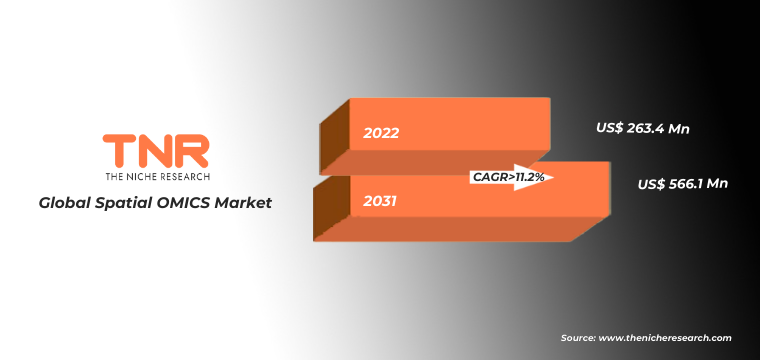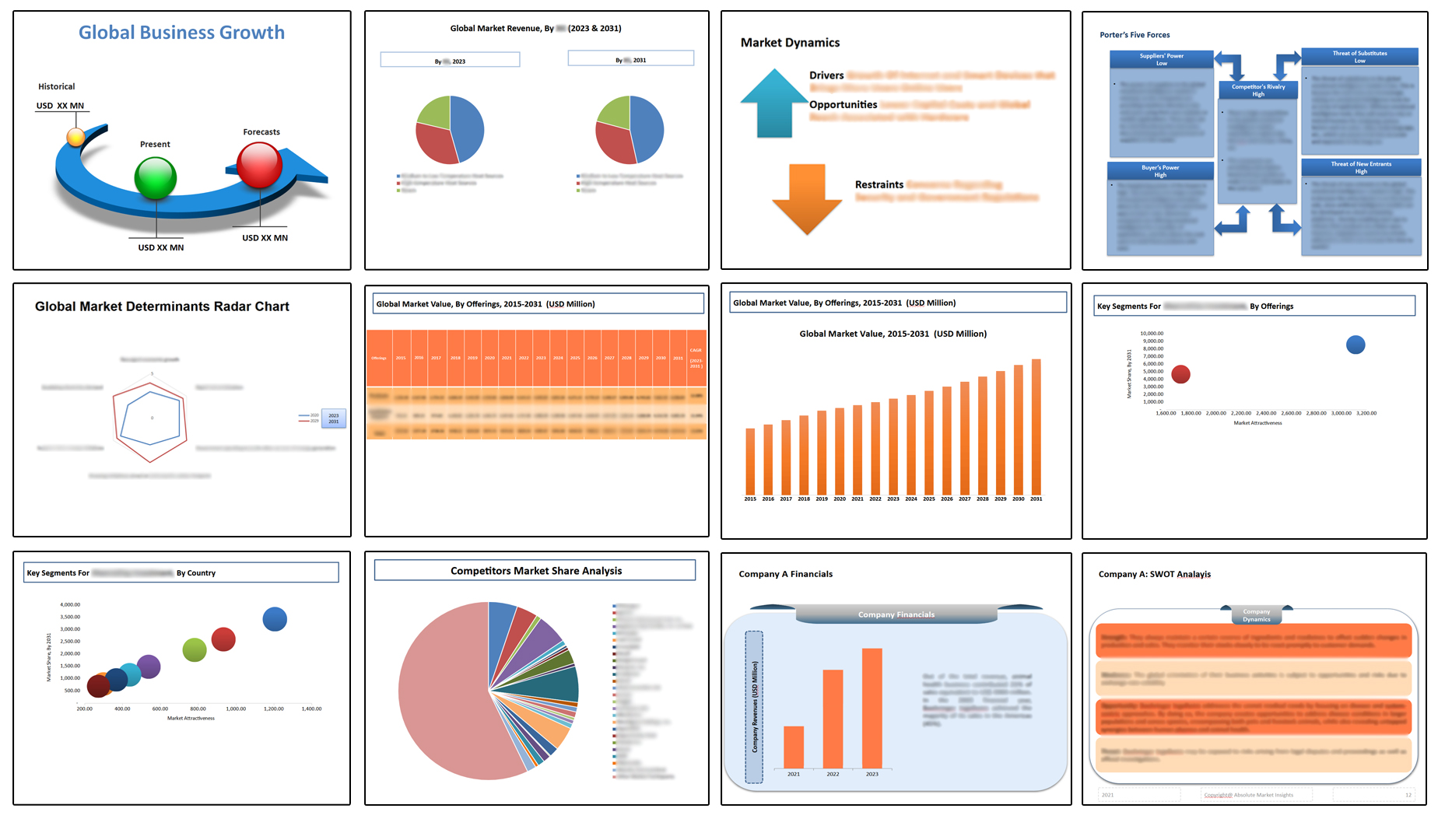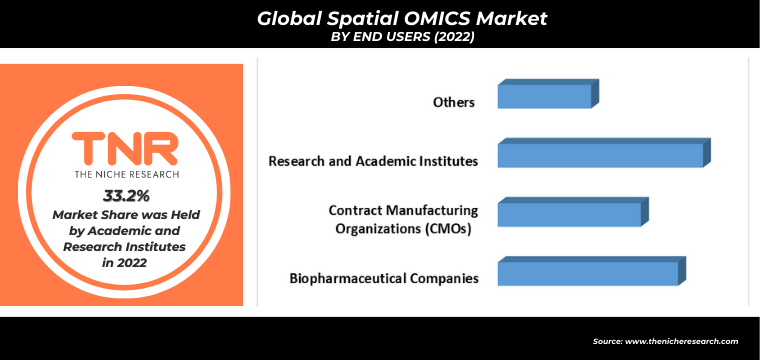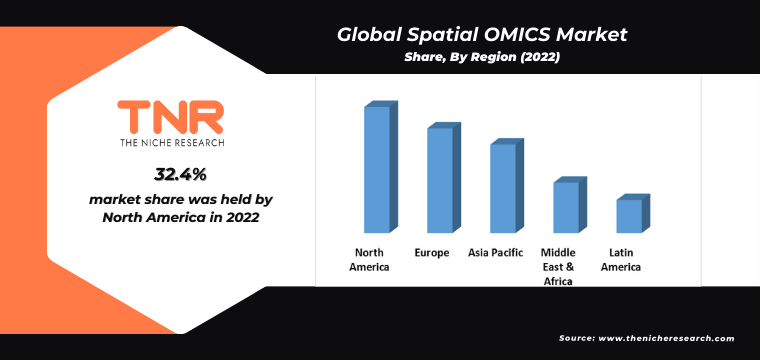Global Spatial OMICS Market By Techniques, By Offerings, By Application, By Sample Type, By End Users, By Region, Segmental Insights (2015 – 2031)
- Industry: Healthcare
- Report ID: TNR-1104-977
- Number of Pages: 420
- Table/Charts : Yes
- November, 2023
- Base Year : 2024
- No. of Companies : 10+
- No. of Countries : 29
- Views : 10189
- Covid Impact Covered: Yes
- War Impact Covered: Yes
- Formats : PDF, Excel, PPT
TNR States, Global Spatial OMICS Market was Valued USD 263.4 Mn in 2022, with an Estimated CAGR of 11.3% by 2031.
Spatial OMICS is a collective term for many technologies that allow OMICS data to be superimposed on tissue pictures. These approaches, in addition to identifying molecular subpopulations of cells, offer knowledge on the spatial localization of the identified subpopulations within the tissue of origin. Furthermore it analyzes their proximity to each other and the extracellular matrix, blood vessels, and other tissue components.
Genomics, for example, examines the entire genome, whereas transcriptomics reads the entire RNA and proteomics examines the protein composition. Spatial OMICS now integrates molecular analysis with geographical information on the location of cells inside tissues. As a result, this technology provides a strong tool for understanding critical systems such as tissue organisation and cell control.
Global Spatial OMICS Market Revenue & Forecast, (US$ Million), 2015 – 2031

Global Spatial OMICS Market Future
Significant advancements in next-generation sequencing and imaging-based methods have resulted in a revolution in the capacity to assess gene expression in tissue slices while maintaining cellular organization. When paired with single-cell RNA-seq, spatial OMICS techniques give a precise picture of cellular heterogeneity and tissue organisation. Moreover spatial OMICS is expected to become more widely adopted across various research areas, including cancer biology, neuroscience, and developmental biology, immunology, and drug discovery. Its integration into clinical diagnostics and personalized medicine is a significant future prospect. Spatially resolved molecular profiling could aid in disease diagnosis, treatment selection, and monitoring patient responses to therapies leading to the growth of spatial OMICS market.
Report Coverage and Deliverables

Spatial transcriptomics is a method that integrates gene expression studies with geographical context of cells. The spatial organisation of cell populations can be determined by mapping gene expression across tissue. Current spatial transcriptomic techniques, on the other hand, lack genuine single-cell resolution, depending on region of interest (ROI) or spot-based capture methods that cannot capture cellular variety properly. Nonetheless, transcriptomics is a potent research tool for discovery. The ability to profile hundreds of thousands of cells and thousands of genes in a single experiment allows for unbiased investigation of the tissue microenvironment, making this method extremely complimentary to imaging-based spatial proteomics.
 Spatial genomics, in particular, has shown to be a vital instrument in disease research. Despite the fact that all human cells have the same genetic information, it is arranged and packed differently. This can influence which genes in each cell are translated into proteins. For example, spatial genomics may be used to isolate genetic variation in non-coding portions of the genome that causes a cell to become malignant. Furthermore, as the costs of DNA sequencing and lab automation fall, spatial genomics is gaining traction, with major centres including the United States, the United Kingdom, and Sweden.
Spatial genomics, in particular, has shown to be a vital instrument in disease research. Despite the fact that all human cells have the same genetic information, it is arranged and packed differently. This can influence which genes in each cell are translated into proteins. For example, spatial genomics may be used to isolate genetic variation in non-coding portions of the genome that causes a cell to become malignant. Furthermore, as the costs of DNA sequencing and lab automation fall, spatial genomics is gaining traction, with major centres including the United States, the United Kingdom, and Sweden.
Spatial OMICS market in North America, particularly in the United States and Canada, has seen significant growth and innovation in recent years. Leading universities and research institutions in North America are actively engaged in spatial OMICS research. They conduct studies across various fields, including cancer biology, neuroscience, developmental biology, and immunology, using spatial OMICS techniques to gain insights into complex biological processes. Major pharmaceutical and biotechnology companies based in North America are integrating spatial OMICS into their drug discovery and development pipelines. This includes applications in target identification, biomarker discovery, and assessing drug effects at the cellular level.

Competitive Landscape
The competitive landscape of spatial OMICS market is marked by innovation, collaboration, and rapid developments in technology and data analysis tools. Startups are contributing to the introduction of novel techniques and platforms, while established players are expanding their portfolios. Academic institutions and collaborative initiatives are fostering knowledge exchange and interdisciplinary research, further propelling the field’s advancement. As the spatial OMICS market continues to evolve, new entrants and developments are expected to shape its landscape further.
Major players operating in the global spatial OMICS market are:
- 10x Genomics
- Agilent Technologies Inc
- Akoya Biosciences
- Bio-Techne
- CD Genomics
- Ilumina Inc
- Indica Labs, Inc.
- Miltenyi Biotec
- NanoString Technologies Inc
- Owkin
- RareCyte, Inc.
- S2 Genomics, Inc.
- SciLifeLab
- Ultivue Inc.
- Visiopharm A/S
- ZEISS
- Other Industry Participants
Global Spatial OMICS Market Report Coverage
| Report Specifications | Details |
| Market Revenue in 2022 | US$ 263.4 Million |
| Market Size Forecast by 2031 | US$ 566.1 Million |
| Growth Rate (CAGR) | 11.2% |
| Historic Data | 2015 – 2021 |
| Base Year for Estimation | 2022 |
| Forecast Period | 2023 – 2031 |
| Report Inclusions | Market Size & Estimates, Market Dynamics, Competitive Scenario, Trends, Growth Factors, Market Determinants, Key Investment Segmentation, Product/Service/Solutions Benchmarking |
| Segments Covered | By Techniques, By Offerings , By Application, By Sample Type, By End Users |
| Regions Covered | North America, Europe, Asia Pacific, Middle East & Africa, Latin America |
| Countries Covered | U.S., Canada, Mexico, Rest of North America, France, The UK, Spain, Germany, Italy, Nordic Countries (Denmark, Finland, Iceland, Sweden, Norway), Benelux Union (Belgium, The Netherlands, Luxembourg), Rest of Europe, China, Japan, India, New Zealand, Australia, South Korea, Southeast Asia (Indonesia, Thailand, Malaysia, Singapore, Rest of Southeast Asia), Rest of Asia Pacific, Saudi Arabia, UAE, Egypt, Kuwait, South Africa, Rest of Middle East & Africa, Brazil, Argentina, Rest of Latin America |
| Key Players | 10x Genomics, Agilent Technologies Inc, Akoya Biosciences, Bio-Techne, CD Genomics, Ilumina Inc, Indica Labs, Inc., Miltenyi Biotec, NanoString Technologies Inc, Owkin, RareCyte, Inc., S2 Genomics, Inc., SciLifeLab, Ultivue Inc., Visiopharm A/S, ZEISS, Other Industry Participants |
| Customization Scope | Customization allows for the inclusion/modification of content pertaining to geographical regions, countries, and specific market segments. |
| Pricing & Procurement Options | Explore purchase options tailored to your specific research requirements |
| Contact Details | Consult With Our Expert
Japan (Toll-Free): +81 663-386-8111 South Korea (Toll-Free): +82-808-703-126 Saudi Arabia (Toll-Free): +966 800-850-1643 United Kingdom: +44 753-710-5080 United States: +1 302-232-5106 E-mail: askanexpert@thenicheresearch.com
|
Global Spatial OMICS Market
By Techniques
- Spatial Transcriptomics
- Immunohistochemistry (IHC)
- Fluorescence In-Situ Hybridization (FISH)
- Sequencing
- In Situ Sequencing (ISS)
- Microdissection Sequencing
- Others
- In-Situ capturing
- Microscopy based RNA imaging techniques
- Padlock Probes & Rolling Circle Amplification
- Single Molecule RNS Fluorescence In-Situ Hybridization (smFISH)
- Branched DNA probes
- Transcriptome In-Vivo Analysis (TIVA)
- Spatial Genomics
- Fluorescence in situ Sequencing
- Fluorescence Microscopy-based
- Others
- Spatial proteomics
- Spatial metabolomics
- Spatial multi-omics
- Others
By Offerings
- Products
- Solutions
- Consumables
By Application
- Biomarker Discovery
- Drug Development
- Cancer Research
- Infectious Diseases
- Immunology
- Metabolic Studies
- Others
By Sample Type
- Frozen tissues
- FFPE tissues
By End Users
- Academic and Research Institutes
- Pharmaceutical and Biotechnology Companies
- Contract Research Organizations (CROs)
- Others
By Region
- North America (U.S., Canada, Mexico, Rest of North America)
- Europe (France, The UK, Spain, Germany, Italy, Nordic Countries (Denmark, Finland, Iceland, Sweden, Norway), Benelux Union (Belgium, The Netherlands, Luxembourg), Rest of Europe)
- Asia Pacific (China, Japan, India, New Zealand, Australia, South Korea, Southeast Asia (Indonesia, Thailand, Malaysia, Singapore, Rest of Southeast Asia), Rest of Asia Pacific)
- Middle East & Africa (Saudi Arabia, UAE, Egypt, Kuwait, South Africa, Rest of Middle East & Africa)
- Latin America (Brazil, Argentina, Rest of Latin America)
Table of Contents
Note: This ToC is tentative and can be changed according to the research study conducted during the course of report completion.
**Exclusive for Multi-User and Enterprise User.
Global Spatial OMICS Market Segmentation
By Techniques
By Offerings
By Application
By Sample Type
By End Users
By Region
**Note: The report covers cross-segmentation analysis by region further into countries
The Niche Research approach encompasses both primary and secondary research methods to provide comprehensive insights. While primary research is the cornerstone of our studies, we also incorporate secondary research sources such as company annual reports, premium industry databases, press releases, industry journals, and white papers.
Within our primary research, we actively engage with various industry stakeholders, conducting paid interviews and surveys. Our meticulous analysis extends to every market participant in major countries, allowing us to thoroughly examine their portfolios, calculate market shares, and segment revenues.
Our data collection primarily focuses on individual countries within our research scope, enabling us to estimate regional market sizes. Typically, we employ a bottom-up approach, meticulously tracking trends in different countries. We analyze growth drivers, constraints, technological innovations, and opportunities for each country, ultimately arriving at regional figures.Our process begins by examining the growth prospects of each country. Building upon these insights, we project growth and trends for the entire region. Finally, we utilize our proprietary model to refine estimations and forecasts.
Our data validation standards are integral to ensuring the reliability and accuracy of our research findings. Here’s a breakdown of our data validation processes and the stakeholders we engage with during our primary research:
- Supply Side Analysis: We initiate a supply side analysis by directly contacting market participants, through telephonic interviews and questionnaires containing both open-ended and close-ended questions. We gather information on their portfolios, segment revenues, developments, and growth strategies.
- Demand Side Analysis: To gain insights into adoption trends and consumer preferences, we reach out to target customers and users (non-vendors). This information forms a vital part of the qualitative analysis section of our reports, covering market dynamics, adoption trends, consumer behavior, spending patterns, and other related aspects.
- Consultant Insights: We tap into the expertise of our partner consultants from around the world to obtain their unique viewpoints and perspectives. Their insights contribute to a well-rounded understanding of the markets under investigation.
- In-House Validation: To ensure data accuracy and reliability, we conduct cross-validation of data points and information through our in-house team of consultants and utilize advanced data modeling tools for thorough verification.
The forecasts we provide are based on a comprehensive assessment of various factors, including:
- Market Trends and Past Performance (Last Five Years): We accurately analyze market trends and performance data from preceding five years to identify historical patterns and understand the market’s evolution.
- Historical Performance and Growth of Market Participants: We assess the historical performance and growth trajectories of key market participants. This analysis provides insights into the competitive landscape and individual company strategies.
- Market Determinants Impact Analysis (Next Eight Years): We conduct a rigorous analysis of the factors that are projected to influence the market over the next eight years. This includes assessing both internal and external determinants that can shape market dynamics.
- Drivers and Challenges for the Forecast Period:Identify the factors expected to drive market growth during the forecast period, as well as the challenges that the industry may face. This analysis aids in deriving an accurate growth rate projection.
- New Acquisitions, Collaborations, or Partnerships: We keep a close watch on any new acquisitions, collaborations, or partnerships within the industry. These developments can have a significant impact on market dynamics and competitiveness.
- Macro and Micro Factors Analysis:A thorough examination of both macro-level factors (e.g., economic trends, regulatory changes) and micro-level factors (e.g., technological advancements, consumer preferences) that may influence the market during the forecast period.
- End-User Sentiment Analysis: To understand the market from the end-user perspective, we conduct sentiment analysis. This involves assessing the sentiment, preferences, and feedback of the end-users, which can provide valuable insights into market trends.
- Perspective of Primary Participants: Insights gathered directly from primary research participants play a crucial role in shaping our forecasts. Their perspectives and experiences provide valuable qualitative data.
- Year-on-Year Growth Trend: We utilize a year-on-year growth trend based on historical market growth and expected future trends. This helps in formulating our growth projections, aligning them with the market’s historical performance.
Research process adopted by TNR involves multiple stages, including data collection, validation, quality checks, and presentation. It’s crucial that the data and information we provide add value to your existing market understanding and expertise. We have also established partnerships with business consulting, research, and survey organizations across regions and globally to collaborate on regional analysis and data validation, ensuring the highest level of accuracy and reliability in our reports.









